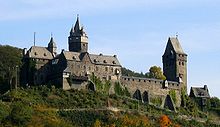County Mark Museum
The Museum of County Mark is a regional history museum founded in 1875, primarily on the history of County Mark . It has significant collections of exhibits from the Middle Ages and early modern times. Many special exhibitions on cultural history make use of loans from the museum. It is housed in Altena Castle , together with the World Youth Hostel Museum it forms the Altena Castle Museums .
history
The Museum of Grafschaft Mark was founded in 1875 as a museum for local and local history in the southern region. It is one of the oldest regional history museums in Westphalia . In 1879 it was housed in a new museum building in Altena .
After Altena Castle was rebuilt as an idealized medieval castle between 1906 and 1915, the Museum of Grafschaft Mark was established in the castle in 1916. In order to fill the significantly increased exhibition space, the collection was greatly expanded. The presentation was carried out in such a way that the objects appeared as if they were in their place of origin. The architectural illusion of a medieval castle was thus continued inside.
The focus of the collection initially included armaments, weapons, sacred works of art, applied arts of all kinds, furniture, agricultural implements as well as paintings and other images. In addition to objects with a regional reference, completely foreign items were also acquired. In the 1930 to 1960s, weapons in particular were collected. After that - until the 1980s - ceramic objects were a focus of the collection.
In addition to the main collection, there were other departments and special museums. The Geological Sauerland Museum has been integrated since the 1930s. There was also an archaeological collection. In the 1950s, the World Youth Hostel Museum was set up to commemorate the establishment of the first youth hostel at the castle. The German Forge Museum has also been located at the castle since 1960, later renamed the Märkisches Schmiedemuseum. The German Wire Museum was added in 1965 . The German Hiking Museum followed in 1984 and the Erzgebirgisches Heimatmuseum in 1988.
There was no overall concept for all collections. A chronological or other comprehensible order was missing.
From 1996 the permanent exhibition was fundamentally redesigned. The focus was on the regional historical component. The objects were arranged chronologically and thematically in a logical order. The economic, social and cultural history of the region plays an important role alongside the history of the county of Mark. The chronology ranges from geology / prehistory to contemporary history. However, the focus is on the Middle Ages and the early modern period .
The German Wire Museum was relocated to another location. Whenever it made sense, some of the exhibits from the other institutions were transferred to the Museum of Grafschaft Mark. The German Hiking Museum and the Erzgebirge Museum of Local History were dissolved. Since then, only the Museum of the County of Mark and the Museum of the World Youth Hostel have remained in the castle. The exhibition itself focuses on important objects and works with staging and other modern museological means. The newly designed museum was opened in 2000.
The Märkische Kreis is responsible for the museums at Altena Castle .
Permanent exhibition
The permanent exhibition begins in the commandant's house with the geology and some archaeological finds. The focus is on the staging of a stalactite cave with a cave bear skeleton. In the Neues Palas, the beginning of Grafschaft Mark and the development of the castle are discussed in a darkened room. In another room, the sovereigns, coins and historical maps of the region are presented. Then it comes to the history of the castle and its rebuilding at the beginning of the 20th century. Among other things, two castle models are shown. In an interactive area, among other things, knight armor can be put on. In the room "In aller Munde" an attempt is made to represent well-known idioms with various exhibits. In the basement, the early iron smelting is shown partly with archaeological finds.
Significant sacred works of art can be seen in the chapel building. These include several important altars from the region. Another room is about the representation of noble life. The large weapons collection is still a focus of the museum. This is divided into hunting and war weapons. In the castle dungeon in the basement of the castle chapel, legal matters such as torture, witch persecution and Veme courts are dealt with.
Tournament weapons, among other things, are presented in the long corridor. This is followed by exhibits on rural life. In the Powder Tower, an attempt is made to illustrate the metal industry tradition, which is so important for the region, by depicting the wire industry, the blacksmith's trade and the display of Iserlohn tobacco boxes . The depiction of city fires, as they often happened in earlier times, is impressively staged.
In the Altes Palas, an attempt is made in a room to illustrate the "costs of industrialization" with different exhibits. In one room entitled “Abysses”, the focus is on the time of National Socialism , the Holocaust and the Second World War . Suddenly it goes into an area “Dütt and Dat” with a wide variety of objects.
literature
- Stephan Sensen: Exhibiting history? The route of the Altena Castle museums. In: Martina Padberg, Martin Schmidt (Ed.): The magic of history. History culture and museum. Bielefeld, 2010 p. 177ff.
- Stephanie Marra : Exhibition review on: Exhibition review: Museum der Grafschaft Mark June 29, 2000, Altena Castle , in: H-Soz-u-Kult, July 24, 2000, online version





